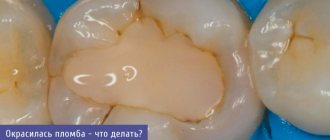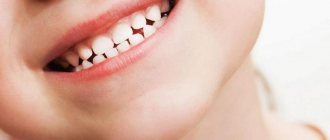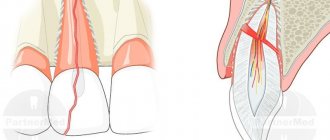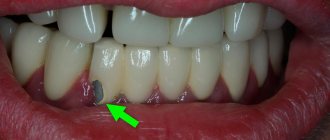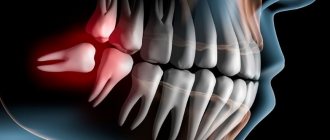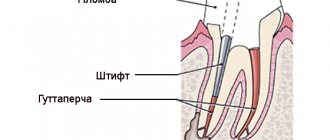Restoring a damaged tooth using a pin is a popular dental technique. A metal rod is fixed in the root canal, after which a filling or artificial crown is installed.
In order for the restored tooth to last longer, it is important to strictly follow the dentist’s recommendations, monitor oral hygiene, and limit the consumption of very hard foods. In some cases, complications may occur after restoration. One of them is loosening of the dental unit. Find out what causes it and how to solve the problem.
Do you need a pin for a crown?
If the doctor insists on prosthetics, this already means that the tooth has undergone significant destruction. The crown helps restore the chewing function of the damaged unit and the aesthetics of the smile, this is especially true for the frontal region. Obviously, the prosthesis must have the necessary support. If there is a sufficient amount of natural tissue, the crown is placed directly on the tooth. In other cases, pins and stump inlays come to the rescue.
- Tooth decay of more than 30% is a good reason for installing a pin and crown.
- A chip of one of the walls of a tooth by 50% or more or a fracture at the root are indications for installing a core inlay and crown.
The technology also has limitations. A pin cannot be placed if there is untreated pulpitis, periodontitis and their complications (cyst, gumboil, etc.). Treatment will have to be abandoned if there are abnormalities in the structure of the tooth roots (too much curvature or thin walls). In some situations, the doctor is unable to unfill the canals after previous endodontic treatment, which also affects the possibility of installing a pin.
Reasons why a dental bridge may fall off
The integrity of the dental bridge is influenced by the following factors:
- The bridge was made to inaccurate measurements. Dentists believe that a bridge can only be made for five crowns and no more, otherwise the bridge design becomes unreliable.
- If the neighboring teeth that support the bridge are poorly prepared for prosthetics, this can also cause the bridge to fly off.
- Crowns for supporting teeth must be made of high-quality material, and they must be fixed with high-quality dental cement.
- Improper oral and dental hygiene. To keep your artificial teeth clean, you should have your teeth professionally cleaned twice a year. If this is not done, the period of wearing dentures will be greatly reduced.
Inlay or pin: which is better?
The choice of support element depends on the specific clinical case. Both the pin and the core tab perform similar functions. However, each solution has its own advantages and disadvantages.
| Crowns on pins | Crowns on core inlays |
|
|
The stump tab is considered a more reliable option for chewing teeth and if it is necessary to install bridges. It is important to understand that this significantly increases the cost of treatment (the price per tab can reach up to 10,000 rubles). In addition, the manufacture of a stump insert requires an additional laboratory stage and appropriate manipulations.
Placing a crown on a pin can be recommended if the tooth does not have serious damage and there is no risk of pin breakage and root canal injury under the influence of chewing load. However, not all pins are suitable for the restoration of anterior teeth, especially if metal-free crowns are used. The crown and post on the front tooth should not contain metal if you want good aesthetics.
When installing a ceramic crown on a front tooth, the core inlay should also be made of ceramic.
Dentist help
The doctor will determine the condition of the stump and name the reason why the crown is loose. A common cause is de-cementation of the reinforcing composition, and then the pin may fall off. After a visual assessment of the condition, x-rays are prescribed. If the crown tab is intact, it did not fall along with the base and did not come off, then the dentist puts the product in place. If there is damage to the tissues, then the open canal will require additional treatment, and a new design will be ordered for the equipment.
What treatment can a doctor prescribe if the pin falls off:
- You can put the fallen crown back in place. To do this, the remaining cement material is removed and the stump is treated with antiseptic.
- The necessary treatment is done on the tooth, then it needs to be attached in place using a special material.
The dentist prepares the tooth for installation of a new structure. The canals and teeth are re-treated, and defects are restored using dental material. Hard tissues are prepared and an impression of the required material is taken. The new design is formed within 7-14 working days.
Three installation steps
If the root has become cemented at the beginning of the pin, then in case of irreversible damage, the structure is removed. Otherwise, an inflammatory process will appear, for example, periostitis or periodontitis. After removal, implants or a bridge are installed. If the structure has fallen out, the treatment at the clinic is free of charge, because dentists provide a guarantee for their work. If the temporary structure at the installation site becomes loose, treatment is provided free of charge. If the warranty period has expired, the treatment will be paid for.
Filling on a pin or crown: which is better?
This question interests many patients, and the answer is obvious. From the point of view of strength and reliability, the best option would be to install a pin and a crown. It is better to place a pin in a tooth under a crown in cases where the tooth is significantly damaged, especially when it comes to molars. A pin with a filling is installed for less significant damage and most often on the front teeth. This method also has its advantages. Firstly, this is a much cheaper technique. Secondly, all treatment takes place in one visit. The patient quickly returns to normal life and forgets about his problem. However, a filling with a pin gives a less reliable and predictable result.
What to do if a temporary bridge falls out
If the temporary bridge falls out, then there is nothing to worry about. After all, it is glued to temporary cement, which has weaker fixing properties. Therefore, you need to contact an orthopedist to glue the structure in place. Or, if a permanent prosthesis is already ready or the implants have taken root, then the temporary bridge will not be put back, but the permanent one will be fixed immediately.
Complex on 4 OSSTEM implants with delayed loading - from RUB 170,000.
Complex implantation Osstem (South Korea) with delayed loading after 4-6 months.
Guarantee for the doctor’s work - unlimited Call now or order a call
Opening hours: 24 hours a day - seven days a week
Stages of installing a crown on a pin
- Initial consultation, determination of indications and contraindications for treatment.
- Preparation of tooth tissues and depulpation of root canals.
- Installation of the pin.
- Taking impressions or 3D modeling. Sending the results to the laboratory to make a permanent crown. Immediately after the procedure, the patient is offered a temporary crown.
- Trying on the finished product and fixing the crown with a pin.
How does the crown stay in place?
Dental crowns made of any materials are fixed in the same way - with dental cement. In the process of preparing for prosthetics, the doctor:
- removes tooth tissue affected by caries;
- treats canals (if pulpitis has developed);
- mounts the pin of the crown part (in case of severe tooth decay);
- grinds the stump to give it the desired shape.
The last manipulation is crucial from the point of view of the correctness of prosthetics. Inside, the crown repeats the stump, outside - the height and geometry of the tooth being restored. Accurate reproduction of parameters directly determines the stability of the prosthesis. Thus, the quality of prosthetics depends on both the dentist and the dental technician.
While the permanent denture is being manufactured, the patient is offered a temporary plastic crown. It protects the remaining part of the tooth from damage and masks the gap well. While wearing a plastic crown, it is not recommended to eat too hard or sticky food.
Service life and design reliability
The service life of a crown on a tooth on a pin is quite decent if the treatment was carried out efficiently, and the patient avoided injury and followed the doctor’s recommendations. Even a classic metal-ceramic crown with a simple anchor pin costs on average 7–8 years. A more expensive ceramic crown on a fiberglass post will last even longer.
If during use the crown begins to wobble, then this is a bad sign, regardless of whether it is with a pin or without a pin. In this case, you need to consult a doctor as soon as possible. If the crown and pin fall out completely, this may be due to improper treatment, pathological processes in the root canals, or a banal injury. Repeated treatment in most cases is no longer possible.
Independent actions
If the pin falls out along with the crown, it can be restored in the clinic after a professional examination by dentists, if the structure was not destroyed. If the crown has fallen off at home, you can do the following yourself:
- If the crown is removed, the stump is cleared of the remaining cement mixture.
- The mouth is rinsed with a solution of Chlorhexidine or hydrogen peroxide.
- If the stump hurts, buy Analgin, Nimesil or Ibuprofen at the pharmacy for pain relief.
- The fallen structure is folded into a box and stored until an appointment with the doctor.
- Depending on the chosen composition, the structure is fixed for 15 days.
- The patient should avoid putting stress on the damaged tooth area.
Analgin
Nimesil
Ibuprofen
After a professional examination, the doctor will name the cause of the problem. If there were technological violations during the installation of the structure, then treatment or restoration of the pins is carried out free of charge.
How much does it cost to put a crown on a post?
The price of the finished solution directly depends on the materials of the pin and crown. The cost of a regular anchor pin is 500 rubles, but for a fiberglass one you will have to pay more than 1000 rubles. But these figures pale in comparison with the range of prices for crowns. If ordinary metal-ceramics costs 6–8 thousand, then products made of ceramics and zirconium will cost three times more. All preparatory manipulations will need to be added to the final amount.
An E-Max ceramic crown on a fiberglass pin, together with all stages of treatment, can cost 30,000 rubles and even more if we are talking about a VIP-class clinic. You can also choose a budget option with a metal-ceramic crown and an anchor or titanium pin. This solution will cost from 12,000 rubles, but is not suitable in all cases.
Prevent it from falling out
Much depends on the work of the orthopedist and dentist, but not everything. The crown will last longer if after prosthetics you strictly follow a few simple rules:
- brush your teeth regularly, use mouthwash, dental floss, and irrigator;
- eliminate the risk of tooth damage due to their improper use;
- Visit a hygienist at least once every six months.
Losing or breaking a dental crown causes discomfort and puts the health of your remaining teeth at risk. Therefore, to prevent trouble from happening unexpectedly, chew your food more carefully, and most importantly, undergo medical examinations. The latter will allow you to detect emerging problems in a timely manner and preserve the crown for as long as possible.
Symptoms
Complications are expressed by the following symptoms.
- Pain due to external impact on the tooth (pressure or chewing) or eating too hot or cold food (has aching character).
- Swelling of the gums.
- Fever, nausea and weakness.
If the pin is not installed correctly, the person's condition may worsen greatly.
Important ! The latter symptoms may indicate the cause of complications after the installation of the pin - allergies.
Installing a pin is a good way to preserve tooth health for at least five to six years. Unfortunately, conventional fillings cannot completely solve the problem of serious damage to dental tissue. The pin installation procedure is painless, and using the latest generation materials can significantly reduce the likelihood of complications.
However, sometimes complications still arise. What could they be?
It was mentioned above that pain often occurs after implantation of the rod. Its reasons are different.
It happens that the dentist did not approach the process of installing the rod professionally enough. The reasons are:
- too deep implantation when the pin comes into contact with the bone;
- the walls of the teeth are damaged, the root canals are perforated;
- small amount of filling material;
- debris of dental instruments entering the tooth canal;
- acute pain may appear due to purulent formation, which leads to swelling of nearby tissues;
- if severe inflammation begins, this is fraught with the occurrence of fistulas due to the effect of purulent discharge on the mucous membranes and gums;
- if the patient has chronic periodontitis, there is a risk of cysts.
If the doctor does not install the pin properly, the patient will experience great discomfort.
Another common cause of pain after a pin is inserted is an allergy to the material from which the pin was made. Signs that the body does not perceive the structure well may include weakness combined with elevated body temperature, as well as inflammation in the oral cavity. Complications also arise when there is insufficient attention to hygiene procedures, for example, brushing the teeth and oral cavity.
If a tooth falls out
Losing a tooth is a reason to think about your health. The examination cannot be delayed; the situation should be corrected as soon as possible:
- determine the causes of tooth loss;
- prevent edentia;
- restore the dentition using a prosthesis or implantation.
Contact any of the Ultra Dent clinics in Simferopol if you notice problems with dentures. If the crown is loose, has fallen off, or you realize that the tooth underneath is rotting, make an appointment with your dentist without delay.
What is the procedure for removing the pin?
At the beginning of the procedure, a rubber dam is installed (latex scarves that are fixed on the teeth with special metal clamps, “clamps”; they are used to isolate the working field). After this, the tooth is thoroughly cleaned of the old filling material to release the pin rod. Then the rod is carefully processed with an ultrasonic instrument, while the pin is gradually loosened and removed from the canal, trying to preserve the tooth tissue as much as possible.
The anchor pin rod is also previously freed from the seal. Then they loosen it with ultrasound and carefully twist it out of the dental cavity.
Parapulpal rods are much easier to pull out than other types of pins. They are not inserted deep into the canal, so no deep intervention is required to remove them. In most cases, it is enough to grab the end and remove it by slightly loosening it. It is not necessary to use ultrasonic devices.
Why do crowns fall out?
This may happen for the following reasons:
- The crown was placed a long time ago, and the service life of the cementing composition (dental glue) has expired.
- The crown was placed on a tooth that was too small (or too thin in shape), which is why it did not fit securely enough.
- The materials used to make the crown were not of the best quality.
- The patient put too much stress on the crown, often eating hard and/or sticky foods.
And, of course, not only a permanent crown, but also a temporary crown can fall out. And sometimes this happens simply because the patient did not show up on time to replace her.
In what cases is a pin placed?
Dentists prescribe pin implantation when the crown is destroyed by more than 50%. In this way, the thinned walls are strengthened. The pin is also installed when building up stumps for artificial crowns.
In what situations is it not recommended to install a pin:
- Is it possible to do an MRI if there are metal crowns?
- the periodontium does not hold the tooth well;
- small root size;
- root caries damage
- the channel is perforated;
- cysts were diagnosed at the roots;
- for blood diseases;
- The walls of the tooth root are very thin.
There are situations when the installation of pins is contraindicated
